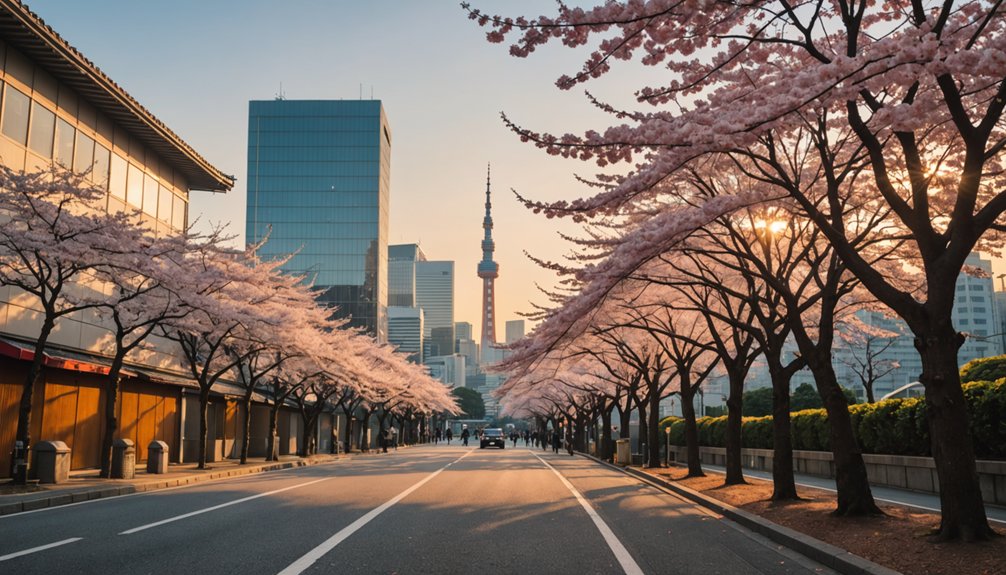You’ll find Tokyo at its most enchanting during spring (March-May) and autumn (September-November), when mild temperatures create perfect conditions for exploring. Spring brings iconic cherry blossoms and hanami festivals, while autumn dazzles with golden foliage and cultural events. If you’re seeking better deals and fewer crowds, consider visiting in January-February or mid-May to mid-June. Each season in Tokyo unfolds its own unique story of traditions and experiences.
Explore East Asia
Find the perfect time to visit these travel hotspots
Key Takeaways
- Spring (March-April) offers ideal weather and iconic cherry blossoms, though expect peak crowds and higher prices during this period.
- Fall (October-November) brings comfortable temperatures, stunning autumn foliage, and fewer tourists than spring season.
- Early December provides pleasant weather, festive illuminations, and relatively peaceful conditions before year-end holiday crowds arrive.
- Late May to early June offers mild weather and lower tourist numbers, making it ideal for budget-conscious travelers.
- January-February has the lowest tourist numbers and best hotel rates, but prepare for cold temperatures around 2-8°C.
Seasonal Highlights in Tokyo
While Tokyo captivates visitors year-round, each season paints the city with distinctly different experiences and cultural celebrations. Spring bursts with iconic cherry blossoms, offering prime cultural immersion through hanami picnics at Ueno Park and Shinjuku Gyoen. You’ll find comfortable temperatures between 10-20°C, perfect for outdoor exploration and participating in March’s bustling events.
Summer transforms Tokyo into a festival paradise, though you’ll encounter humidity and temperatures above 30°C. The spectacular Sumida River Fireworks and vibrant matsuri festivals provide authentic seasonal sights, while air-conditioned themed cafés offer refuge from the heat. Winter brings magical evening strolls through glittering illuminations across the city. During autumn, the city’s landscapes turn golden and crimson, particularly at Koishikawa Korakuen. With mild temperatures of 15-25°C, you can comfortably experience tsukimi moon-viewing traditions and the prestigious Tokyo International Film Festival, making this season ideal for both outdoor adventures and cultural activities.
Peak Vs Off-Peak Tourism Periods
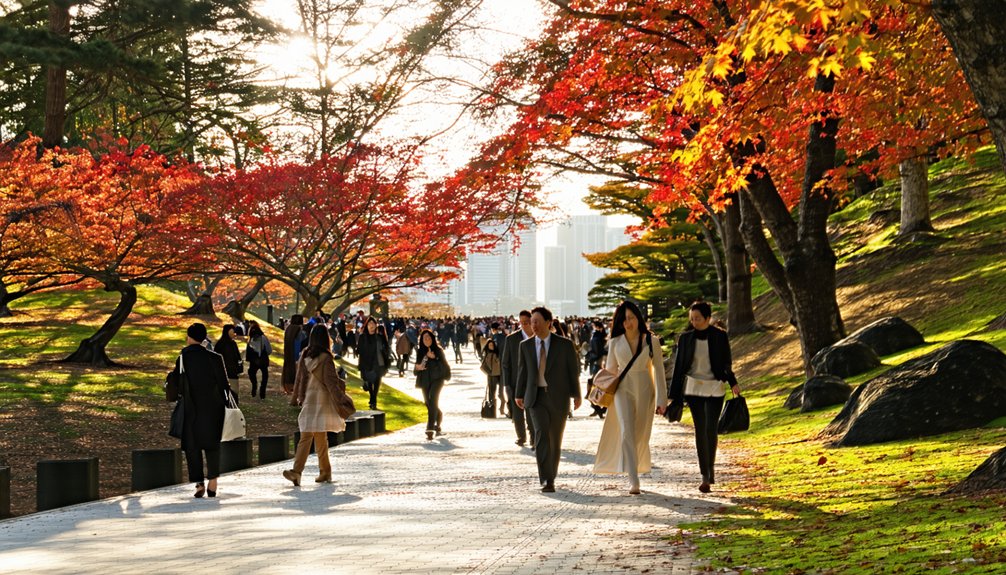
Three distinct peak seasons dominate Tokyo’s tourism calendar, with cherry blossom season in spring drawing the largest crowds. You’ll experience intense tourist crowd dynamics from late March to mid-April, when accommodation availability drops drastically and rates soar 40-60% above winter prices. The autumn foliage season (October-November) creates a similar surge, while summer festivals in July-August attract massive crowds despite the humidity. Foreign tourist numbers have been rapidly increasing since April 2023.
If you’re seeking a more relaxed experience, consider visiting during the off-peak periods. January and February offer the best accommodation availability and winter discounts of 15-25%, though you’ll need to bundle up. The sweet spot falls between mid-May and mid-June, after Golden Week but before the rainy season, when you’ll enjoy mild weather and reasonable rates. Early December also provides a peaceful window before the year-end illumination crowds arrive, giving you breathing room to explore the city’s attractions.
Weather Patterns Throughout the Year
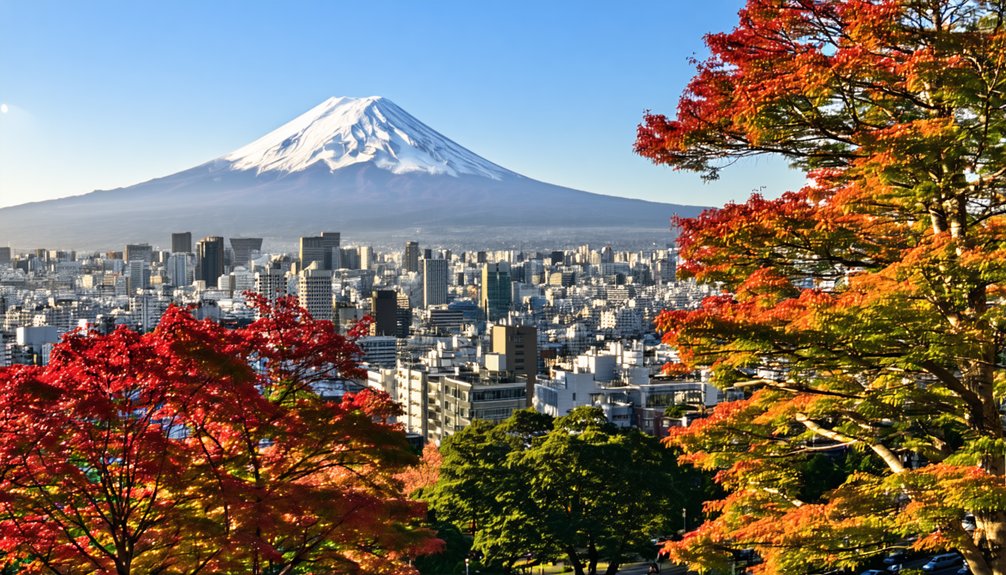
You’ll encounter distinct seasonal shifts in Tokyo, from winter lows around 2°C to humid summer days reaching 32°C, with spring and autumn offering milder temperatures ideal for outdoor exploration. The city’s precipitation peaks during the September-October typhoon season, when monthly rainfall can exceed 230mm, while December remains the driest month with just 62mm. While summer brings challenging humidity levels above 70%, you can expect pleasant conditions during spring’s cherry blossom season in late March and autumn’s cooling temperatures from late October through November. Winter visitors should prepare for the influence of the Siberian High pressure system, which brings cold air masses across Japan.
Seasonal Temperature Changes
Tokyo’s seasonal rhythms create four distinct climate chapters throughout the year, each with its own temperature signature. You’ll experience mild winters with daytime highs around 10-12°C, though nights can dip to 2-3°C. Spring brings gradual warming, with temperatures climbing from March’s 14°C to May’s pleasant 23-24°C.
Summer releases intense heat, particularly in August when temperatures can soar past 35°C, with humid nights rarely falling below 23°C. A brief rainy season occurs from June through July, bringing light showers to the metropolitan area. The thermal variability eases into autumn, as September’s lingering warmth (27-30°C) shifts to November’s cooler embrace (12-17°C).
Your seasonal attire needs will vary greatly – from light layers in winter to breathable fabrics in summer. The urban heat island effect keeps Tokyo notably warmer than surrounding areas, especially during winter nights.
Rain and Humidity Impact
Beyond temperature variations, rainfall and humidity shape your Tokyo experience markedly throughout the year. The city’s rain patterns follow distinct seasonal rhythms, with September and October seeing the heaviest precipitation due to typhoon influence. You’ll encounter peak humidity during summer months, particularly June through August, when levels reach 72-76%. The city receives approximately seven inches of rainfall during June’s rainy season.
| Season | Rain Pattern | Humidity Trend |
|---|---|---|
| Summer | Rainy season | Very high (75%) |
| Fall | Typhoon risk | Moderate (65%) |
| Winter | Minimal rain | Low (50%) |
For maximum comfort, plan around these weather patterns. Winter offers the driest conditions with minimal rainfall (under 70mm monthly) and lower humidity levels. The June-July rainy season brings intermittent showers rather than constant downpours, while September-October demands flexibility due to potential typhoon disruptions.
Major Weather Events
Throughout the year, distinct weather patterns roll through Tokyo, bringing everything from winter cold snaps to intense summer heatwaves. You’ll encounter various extreme weather events that shape the city’s rhythm and might affect your travel plans.
Key weather patterns you’ll experience:
- Winter cold spells with temperatures dropping to 5-7°C, rarely reaching below freezing
- Spring’s temperature swings driven by alternating warm and cold fronts
- Summer heatwaves pushing temperatures above 33°C with intense humidity
- Late-summer typhoons bringing storm surge impacts and transport disruptions
The city’s weather has grown more intense in recent years, with stronger typhoons extending into November and record-breaking summer temperatures. While Tokyo’s urban heat island effect moderates winter chills, it intensifies summer heat, especially in the city center. The city experiences approximately 1600 mm of rainfall annually, with the heaviest precipitation occurring during the typhoon season.
Major Festivals and Cultural Events
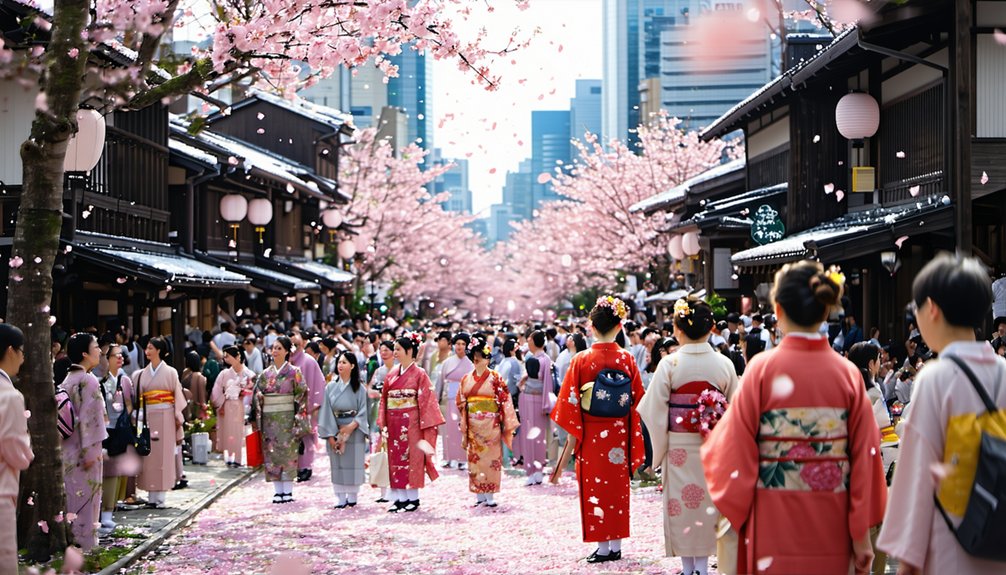
Dozens of vibrant festivals and cultural celebrations shape the rhythm of life in Tokyo, making festival timing a key factor in planning your visit. You’ll find seasonal highlights throughout the year, from spring’s ethereal cherry blossom festivals to summer’s spectacular fireworks displays. Major events include the Sanja Matsuri in May, where three mikoshi (portable shrines) parade through ancient Asakusa’s streets, and July’s Mitama Matsuri, illuminating Yasukuni Shrine with thousands of lanterns. The unique Daradara Matsuri in September features traditional ginger sales and marriage charms at Shiba Daijingū.
Don’t miss autumn’s Tokyo International Film Festival or winter’s dazzling illuminations throughout the city. Year-round events like sumo tournaments and weekend festivals at various shrines offer cultural immersion whenever you visit. The biennial Kanda Matsuri, one of Tokyo’s three greatest festivals, draws massive crowds in odd-numbered years. For maximum festival exposure, plan your visit during Golden Week (late April to early May) when multiple celebrations converge in a spectacular display of Japanese tradition.
Cost Considerations for Different Seasons
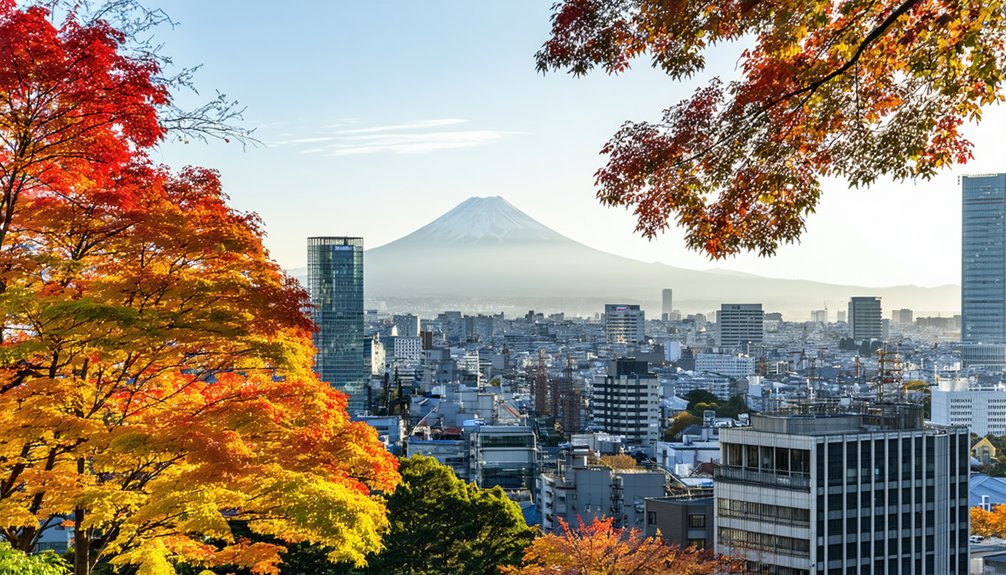
Tokyo’s peak seasons during spring cherry blossoms and autumn foliage can strain your wallet, with hotel rates reaching ¥20,986 ($136) per night and flights costing up to $1,200 roundtrip. You’ll find significant savings by visiting during winter months when hotel prices drop to as low as $25 per night for hostels, and flight costs decrease by 15-20% compared to spring peaks. While summer offers moderate pricing, you’ll want to avoid the premium rates during special holidays like Obon Week and New Year’s, when accommodations can surge by 30%. You can save on daily transportation costs by utilizing the JR West Rail Pass for unlimited train travel throughout your stay.
Peak Vs Low Pricing
Savvy travelers looking to explore Japan’s capital can save markedly by understanding Tokyo’s distinct pricing seasons. Flight costs and accommodation rates follow predictable patterns, with airline route fluctuations and transportation logistics playing key roles in overall expenses.
- Cherry blossom season (late March-April) commands premium rates, with hotels reaching ¥20,986 ($136) per night
- Winter months (January-February) offer substantial savings, except during New Year celebrations
- Rainy season (June-July) presents value opportunities with up to 25% lower flight costs
- Late autumn (November) balances affordable rates with pleasant weather
You’ll find the most significant price differences in accommodations, where peak season rates can double compared to off-peak periods. During off-peak months, budget travelers can find local attractions discounted significantly. Planning around these fluctuations helps maximize your budget while experiencing Tokyo’s diverse seasonal offerings.
Seasonal Value Deals
Five distinct seasonal periods offer exceptional value for budget-conscious Tokyo travelers. Winter sales slash average daily expenditures by up to 80% on fashion, while January’s fukubukuro lucky bags deliver mystery items worth several times their price. For budget friendly shopping tips, target summer clearances at Shibuya 109 and Lumine malls, where discounts reach 70% by mid-July. Off-peak periods during the rainy season bring significant savings on flights and accommodations, with capsule hotels dropping rates by half compared to peak seasons. Golden Week rewards big spenders with cash-back campaigns at major department stores, while year-end promotions feature luxury goods at 30-40% off during corporate bonus season. Strategic timing of your visit can dramatically reduce travel costs while maximizing shopping opportunities. Savvy shoppers can capitalize on two major bonus seasons when Japanese companies pay employees extra, leading to increased retail promotions and deeper discounts.
Essential Planning Tips for Each Month
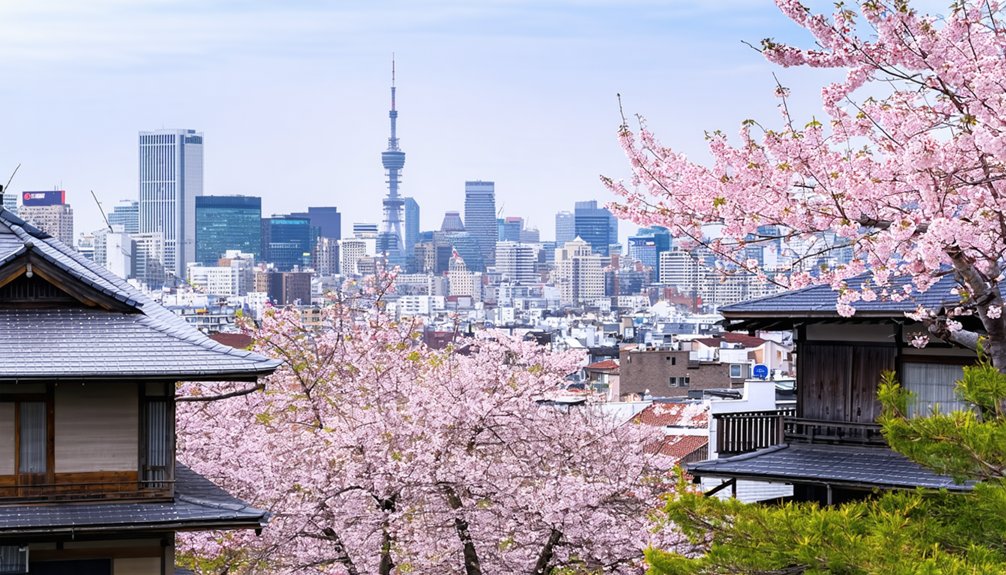
Planning your Tokyo visit requires careful consideration of each month’s distinct characteristics, from winter’s serene illuminations to spring’s cherished cherry blossoms. You’ll want to align your travel dates with your ideal weather preferences and crowd tolerance while keeping seasonal fashion trends in mind.
Tokyo’s seasonal charm unfolds uniquely each month, inviting travelers to choose their perfect moment amid changing weather and crowds.
- January-February offers peaceful exploration with thermal layers essential for temperatures around 2-11°C. Both months provide lower accommodation costs compared to peak seasons.
- March-April brings the iconic sakura season, requiring light jackets and advance bookings
- May delivers perfect hiking weather with temperatures of 15-23°C, best for outdoor adventures
- June introduces the rainy season, demanding quick-dry fabrics and portable umbrellas
For recommended packing, consider the humidity levels and temperature swings within each month. Winter visitors should pack waterproof footwear and thermal wear, while spring travelers can opt for lighter layers. Remember that Tokyo’s weather can shift dramatically, so versatile clothing choices will serve you best, regardless of when you visit.
Transportation and Accommodation Strategy

While Tokyo’s extensive transit network may seem overwhelming at first, mastering the city’s transportation and accommodation options will make your visit smoother and more budget-friendly. Start by getting a Suica or Pasmo IC card for seamless travel across all transit systems, from subway lines to buses, with fares ranging from ¥170-¥310 per ride. Trains in Tokyo are known for being punctual and clean, though they can get quite crowded during peak hours.
For accommodations, choose based on your preferred access to the JR Yamanote Line. Shinjuku and Shibuya offer excellent connectivity plus vibrant neighborhoods, with options spanning from ¥3,000 hostel beds to luxury rooms at the Park Hyatt. Compare hotel amenities carefully – while budget business hotels provide essential comforts like free Wi-Fi and compact rooms from ¥8,000, luxury properties include concierge services and high-end dining. Consider Tokyo Station area hotels for easy airport access and Asakusa for budget-friendly stays near cultural sites. Most properties offer luggage storage for early arrivals, letting you explore immediately upon reaching the city.

